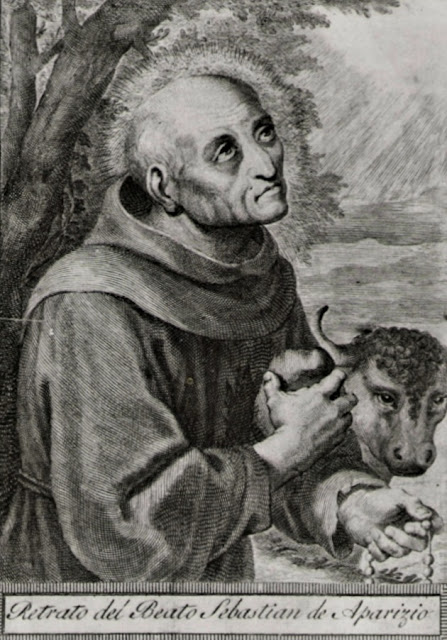Submissive to the Way of the Cross
Memorial: August 27th
This August I feature another little-known mystic named María Pilar Izquierdo Albero – she was a founder of a religious congregation who suffered much to fulfill a mission for the poor tasked upon her by God. Although she experienced one setback after another, she managed to turn the many “lemons” thrown her way into a large batch of the sweetest lemonade for Jesus!
Maria Pilar (or simply “Pilar”, as she was called) was born in 1906 into a large family from Zaragoza, Spain. Raised under impoverished but devout circumstances, she grew up unschooled but with a highly pious and generous disposition. At 12, she contracted a mysterious illness that often left her debilitated. When she recovered sufficiently after four years of intermittent poor health and hospital stays, she worked in a shoe factory until a fall at 20-years-old resulted in a broken pelvis, which lead to her becoming partially paralyzed a year later. This paralysis soon spread throughout Pilar’s body, leaving her bedridden and barely able to speak. To make matters worse, she developed skin ulcers (likely bedsores); went completely blind; and became hearing impaired, too! Due to these circumstances, her entire family also suffered and was forced to move to a small attic, while sometimes relying on charity to get by.
In 1929, the poor patient's state of decline was so bad, after a bout of severe chest pains, she lapsed into a coma. Doctors pronounced her case hopeless and her priest administered the last rites. All expected her to die, but the Lord had other plans for her ... and she woke up six months later.
Despite the onslaught of illnesses and misfortunes, Pilar displayed admirable faith and calm. Rather than wallowing in misery and self-pity, or falling into despondency, she instead resigned herself to God's will; embracing her physical and moral suffering as a way of attaining closer union with Christ. In fact, the Beata began experiencing mystical encounters with our Lord, who invited her to become a “victim soul” for sinners - especially Priests and Seminarians - to which she generously consented. Not surprisingly, other spiritual charisms followed:
- the Sacred Stigmata, which she suffered interiorly without external wounds
- frequent Ecstasies during which she had visits from Jesus, the Blessed Virgin, and Saints
- Reading of Souls and Prophetic Insight
- Bilocation
For the next ten years, Pilar patiently suffered and her reputation for sanctity became widespread throughout the region, attracting pilgrims to her humble sickroom. During the Spanish Civil War that raged between 1936 to 1939, she was inundated by visitors seeking her prayers and clamoring to get divine insight about loved ones fighting in the war.
On December 8, 1939 – the Feast of the Immaculate Conception – Pilar was totally healed. Months earlier Jesus had actually expressed his desire for a charitable work to be established in Spain to uplift the people from the misery left behind by the recently ended war ... and he foretold to the invalid her imminent healing since he apparently wanted her to be the person to accomplish it. So upon her miraculous recovery, Pilar immediately set about the task of establishing a new congregation "to reproduce the active life of the Lord on earth through works of mercy".
Pilar moved to Madrid with a group of collaborators and there started the Missionaries of Jesus and Mary, which the local bishop approved as a Pious Union. Things were going well, at first, until the following year when calumnies surfaced accusing her of vile things such as being mentally ill; diabolically possessed; or even an outright fraudster aiming to gain personal wealth to escape poverty. As a result of the negative press, her bishop withdrew his approval and ordered that the Missionaries be dissolved. Pilar again submitted to God’s will.
In spite of this setback, Pilar and her companions continued their ministry as laywomen serving the poor in the slums of Madrid and their work thrived.
companions in ministry
A second review in 1942 of the Beata's work resulted in the approval of a revamped association - the Pious Union of the Missionaries of Jesus, Mary, and Joseph - but in 1944, the foundress was forced out of her own community after new slanders were spread against her. Pilar left with nine loyal spiritual daughters, offering her humiliations and sufferings to God for the survival of her mission. They moved to San Sebastiano to start all over again and there Pilar was diagnosed with stomach cancer. Almost simultaneously with the diagnosis, the Beata suffered a broken leg from another accident leaving her bedridden again! She succumbed to her maladies on August 27, 1945 being only 39-years-old.
Pilar’s many, many sacrifices eventually proved to not be in vain, as her small group of spiritual daughters persevered. While the pious union floundered, the women who remained with her managed to reestablish themselves in May 1948 as the Missionary Work of Jesus and Mary; it was officially recognized as a new congregation of the Church in 1961. Thus, their founder's legacy lived on and today flourishes through 24 houses scattered throughout Spain, Colombia, Ecuador, Indonesia, Italy, Mexico, Mozambique, and Venezuela.
For her holy example of faith; charitable service to the poor and needy; humility and patience in suffering; and submission to God’s divine will, Maria Pilar Izquierdo Albero was Beatified in November 2001. One more miracle is still needed to raise her to Sainthood. Please join this ministry in praying for its realization.
Bl. Maria Pilar, pray for us!




































